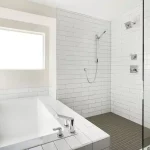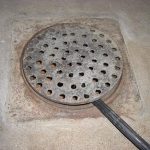If you’re thinking of turning your basement into a livable space or dealing with dampness, you’ll need to know about the basement floor drain cover with a hose connection. The basement floor drain connects with the main drainage or sewage system of your city, allowing for efficient waste removal. However, leaving the drain open can allow sewage gas to enter your home.
To prevent this, we suggest covering the basement floor drain with cement or plugs. Additionally, you can connect a hose to the drain to drain your air-purifying or dehumidifying devices. Installing the cover is straightforward, and you can secure the hose attachment with Teflon tape for better drainage. You can even detach the hose from the floor drain cover by removing the tape around it.
In this article, we’ll delve deeper into the hose connection with the basement floor drain, providing you with all the necessary information for effective home management.
Can You Cover a Floor Drain in the Basement?
Yes, you can easily cover your basement floor drain. For permanent coverage, use concrete or cement. For temporary coverage, use metal or plastic caps, which can be purchased at your local hardware store and easily installed by following the user guidelines. No plumbing skills are required.
How to Attach Basement Floor Drain Cover with Hose Connection?
Steps to Connect the Hose with the Floor Drain:
Connecting a hose to your basement floor drain is a great way to drain the tank reservoir of your dehumidifier. Here are the steps you need to follow:
- Check the size of the holes in your floor drain cover before selecting the right size drain hose to insert through them. A garden hose with a ½-inch or 5/8-inch size is ideal for this purpose.
- Determine whether you want to connect the hose to the drain cover permanently or temporarily. We recommend connecting it temporarily, but make sure to secure it with Teflon or plumbing tape to prevent leakages around the hose and drain cover connecting points.
- Measure the length of the hose so that it reaches the floor drain from the point it will work in the basement. This will help you attach and maintain it better.
An important note: You can also remove the floor drain cover and insert the hose directly through the drain. This is useful for sweeping and cleaning the basement or your automobiles, and it allows for better water flow since mounting a larger diameter hose through the drain cover hole can be tough.
Use of Metal Cutting Blade:
If you want to cut through the drain cover for better attachment, use a metal-cutting blade to cut through it carefully. Follow these steps:
- Use chalk to mark the space you want to cut and follow the marked line.
- Be attentive while cutting the drain cover to avoid damaging the slab.
- Once you have cut through a small segment of the drain cover, you can insert the hose through it and secure it with Teflon tape.
The above discussion shows that connecting a hose to your basement floor drain cover is easy, but you need to understand different coverage options for the floor drain.
3 Different Options to Cover the Basement Floor Drain:
If you have a basement floor drain, you know how important it is to keep it covered. In this section, we’ll discuss three different options for covering your basement floor drain.
Seal the Floor Drain:
If you want a permanent solution for covering your basement floor drain, you can seal it with cement or concrete. This will prevent sewage backflow and keep your floor in good condition for an extended period. We recommend using hydraulic cement for the best results. This type of cement is commonly used in masonry to stop leakage. You can also leave a small hole in the seal cover (around ½ to 5/8 inches) to insert a hose through it.
Use a Cap or Lid:
A lid or cap attachment is a great temporary solution for covering your basement floor drain. Since it’s removable, you can easily unblock the drain whenever needed. Caps are available in both plastic and metal versions, but we recommend using metal caps for a sturdier solution. You can even cut through the metal cap to connect a hose directly to the drain and remove water from the basement. Caps come in three different options:
- Pressure plugs
- Twist plugs
- Twist ball
Caps also work well with dehumidifiers to drain their tank reservoir without removing them from the machine, making basement maintenance much easier.
Threaded Cover:
If you have PVC pipes for your drain, you can seal the drain cover with a threaded plug. This is a better option because it won’t pop out due to backflows. It’s a great way to keep your basement floor drain covered and prevent any unwanted water from entering your basement.
In summary, there are different options available to cover your basement floor drain. Whether you want a permanent solution or a temporary one, these three options will help keep your basement dry and in good condition.
4 Benefits of Using Hose Connection with The Basement Floor Drain Cover:
Using a hose connection with the basement floor drain cover can bring multiple benefits to your property. Here are some of them:
- Effortless Cleaning: The hose connection allows you to clean the basement with ease. Dirt and grime can be removed effortlessly, leaving your basement sparkling clean.
- Dehumidifier Connection: The hose connection also helps you connect your dehumidifier to drain its tank reservoir. This feature is especially useful in humid climates, where moisture can build up quickly.
- Unblock Drainpipe: Connecting a hose through the drain cover allows you to unblock the drainpipe through the hose. This feature can save you time and money by avoiding the need for a plumber.
- Quick Unclogging: Running water through the hose at high speed can unclog the drainpipe quickly, even without removing the cover. The hose attachment is also easy to remove, so you can do it whenever required.
By connecting a hose through the floor drain cover of your basement, you can maintain your property perfectly and increase its value.
Conclusion:
In summary, incorporating a basement floor drain cover with a hose connection is a smart choice for maintaining your basement floor.
This simple addition provides added convenience and ease of maintenance. As an experienced plumber, I recommend this product for new construction projects or as a retrofit option for existing foundations.
By attaching a hose to the drain cover, you can quickly and efficiently clean your basement floor. Trust the expertise of a professional plumber like myself and consider adding this product to your home.




